|
Battle of the Crater History
Battle of the Crater, or Battle of the Mine
American Civil War Battle of the Crater, July 30, 1864
The Battle of the Crater
July 30, 1864
After weeks of preparation, on July 30 the Federals exploded a mine in Burnside’s
IX Corps sector beneath Pegram’s Salient, blowing a gap in the Confederate defenses of Petersburg. From this propitious
beginning, everything deteriorated rapidly for the Union attackers. Unit after unit charged into and around the crater, where
soldiers milled in confusion. The Confederates quickly recovered and launched several counterattacks led by Maj. Gen. William
Mahone. The break was sealed off, and the Federals were repulsed with severe casualties. Ferrarro’s division of black
soldiers was badly mauled. This may have been Grant’s best chance to end the Siege of Petersburg. Instead, the soldiers
settled in for another eight months of trench warfare. Maj. Gen. Ambrose E. Burnside was relieved of command for his role
in the debacle.
| Battle of the Crater, Petersburg, Civil War Map |
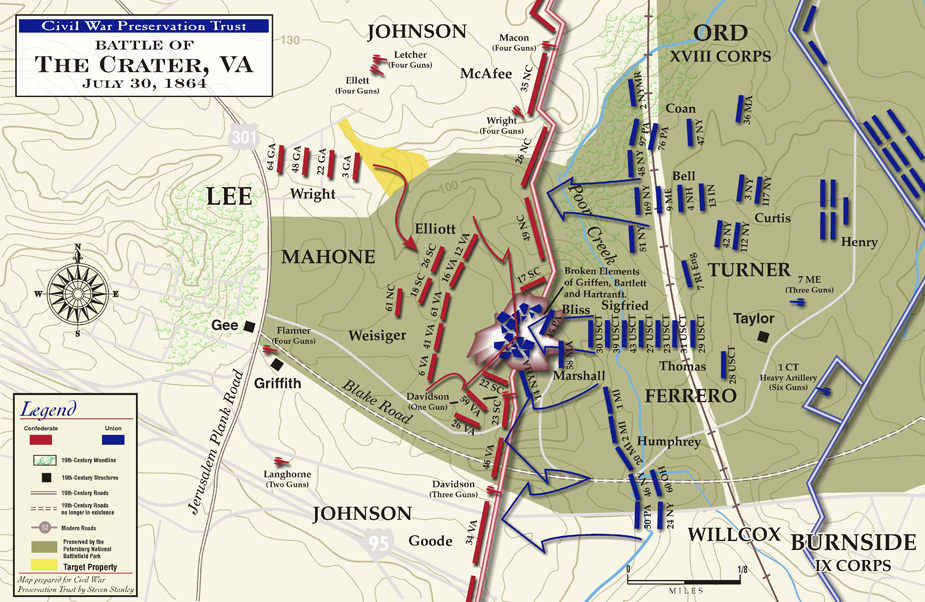
|
| Battlefield Map of Union and Confederate Troop Positions at the Crater |
(About) Map of Union and Confederate
lines in Petersburg trenches on July 30, 1864, with Union Mine explosion under Confederate position,
thus causing massive “Crater”, and then direction of Union advance and engagement with Confederate units. Click
to enlarge. Map courtesy Civil War Preservation Trust.
At several places east of the city the opposing lines were extremely close together. One of these locations
was in front of Elliott's Salient, a Confederate strong point near Cemetery Hill and old Blandford Church. Here the Confederate position and the Union picket line were less than 400 feet
apart. Because of the proximity of the Union line, Elliott's Salient was well fortified. Behind earthen embankments was a
battery of four guns, and two veteran South Carolina infantry
regiments were stationed on either side. Behind these were other defensive works; before them the ground sloped gently downward
toward the Union advance line.
This forward Union line was built on the crest of a ravine which had been crossed on June 18. Through this
ravine, and between the sentry line and the main line, lay the roadbed of the Norfolk and Petersburg Railroad. The front in this sector
was manned by Gen. Ambrose E. Burnside's IX Corps. Among the many units which composed this corps was the 48th Regiment, Pennsylvania
Veteran Volunteer Infantry. A large proportion of this regiment had been coal miners, and it seemed to have occurred to one
or more of them that Elliott's Salient would provide an excellent place to use their civilian occupation. Lt. Col. Henry Pleasants,
the commanding officer of the 48th and a mining engineer by profession, overheard one of the enlisted men mutter, "We could
blow that damned fort out of existence if we could run a mine shaft under it." From this and similar remarks came the germ
of the idea for the Union mine. This is what the 48th Regiment proposed to do: dig a long
gallery from the bottom of the ravine behind their picket line to a point beneath the Confederate battery at Elliott's Salient,
blow up the position by means of powder placed in the end of the tunnel, and, finally, send a strong body of troops through
the gap created in the enemy's line by the explosion. They saw as the reward for their effort the capitulation of Petersburg and, perhaps, the end of the war.
| Battle of the Crater Map |
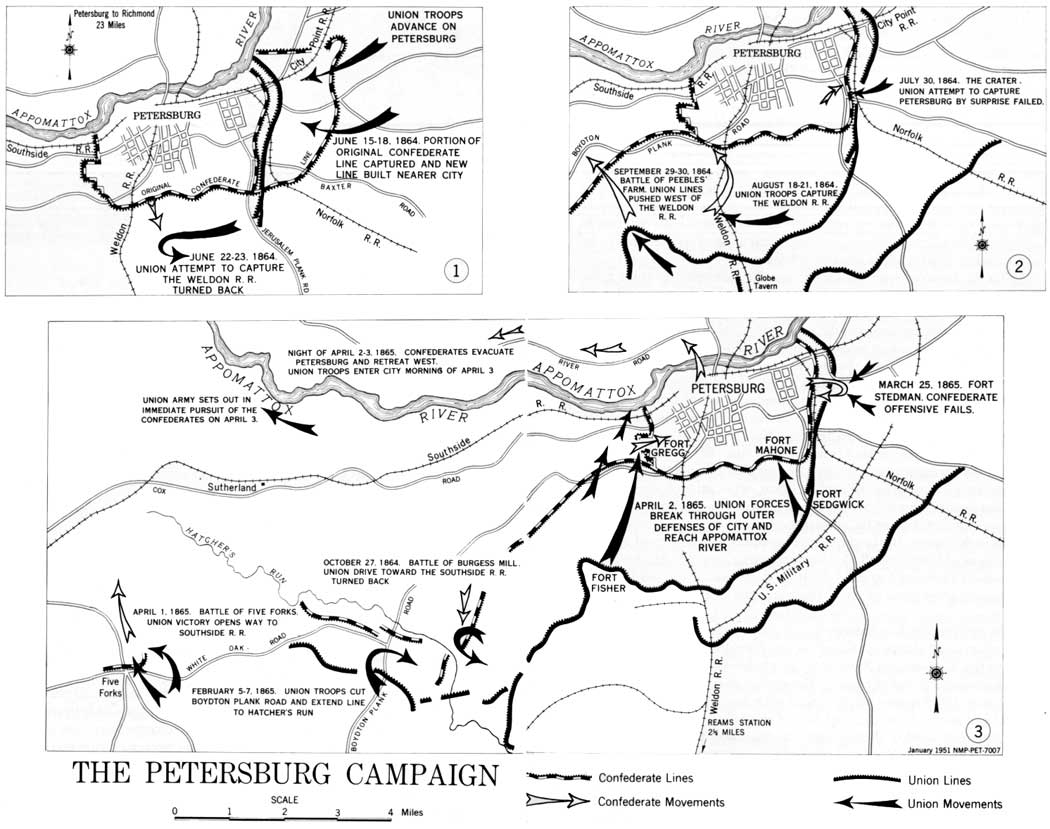
|
| Civil War Petersburg Campaign Map of Battlefields |
| Civil War Trenches of Petersburg, Virginia |
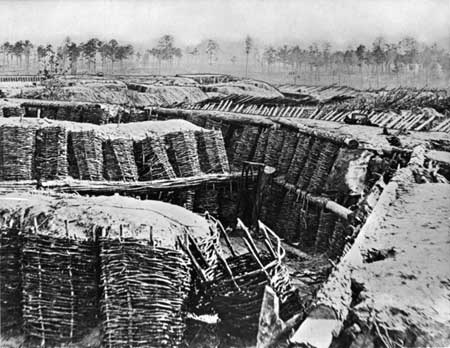
|
| Union siege line and trench around Petersburg |
| Union Tunnel to the Mine at Petersburg, Civil War |
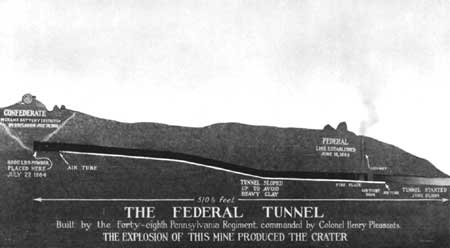
|
| Explosion of Federal Mine produced the massive "Crater" |
(Above) Built by the 48th Pennsylvania Regiment, the long shaft served
as host to the immense amount of gunpowder that caused the crater at Petersburg. The mine was not altogether unique, however.
At Vicksburg, during the previous July in 1863, a similar yet smaller mine was detonated under the 3rd Louisiana Redan during
Grant's Siege of Vicksburg. The large abyss at Petersburg was considerably larger than the Vicksburg crater that had been
caused by some 2,200 pounds of gunpowder. While the massive crater at Petersburg was the result of 8,000 lbs. of gunpowder,
it was also unique because black troops spearheaded the disastrous advance into
the large pit. Both mines had eerily familiar outcomes: Union men had advanced only to be repulsed, and neither event had
any material impact on its battle.
After obtaining the permission
of Burnside and Grant, Pleasants and his men commenced digging their mine shaft on June 25. The lack of proper equipment
made it necessary constantly to improvise tools and apparatus with which to excavate. Mining picks were created from straightened
army picks. Cracker boxes were converted into hand barrows in which the dirt was removed from the end of the tunnel. A sawmill
changed a bridge into timber necessary for shoring up the mine. Pleasants estimated both direction and depth of the tunnel
by means of a theodolite (old-fashioned even in 1864) sent him from Washington. The outmoded instrument served its purpose
well, however; the mine shaft hit exactly beneath the salient at which it was aimed.
Recommended Reading: Into the Crater: The
Mine Attack at Petersburg, by Earl J. Hess. Description: The battle of the Crater on July 30, 1864, was
the defining event in the 292-day campaign around Petersburg, Virginia, in the Civil War and one of the most famous engagements
in American military history. Although the bloody combat of that "horrid pit" has been recently revisited as the centerpiece
of the novel and film versions of Charles Frazier's Cold Mountain, the battle has yet to receive a definitive historical study.
Distinguished Civil War historian Earl J. Hess fills that gap in the literature of the Civil War with Into the Crater. Continued
below...
The Crater was central in Ulysses S. Grant's third offensive at Petersburg and required digging of a five-hundred-foot
mine shaft under enemy lines and detonating of four tons of gunpowder to destroy a Confederate battery emplacement. The resulting
infantry attack through the breach in Robert E. Lee's line failed terribly, costing Grant nearly four thousand troops, among
them many black soldiers fighting in their first battle. The outnumbered defenders of the breach saved Confederate Petersburg
and inspired their comrades with renewed hope in the lengthening campaign to possess this important rail center. In this narrative
account of the Crater and its aftermath, Hess identifies the most reliable evidence to be found in hundreds of published and
unpublished eyewitness accounts, official reports, and historic photographs. Archaeological studies and field research on
the ground itself, now preserved within the Petersburg National Battlefield, complement the archival and published sources.
Hess re-creates the battle in lively prose saturated with the sights and sounds of combat at the Crater in moment-by-moment
descriptions that bring modern readers into the chaos of close range combat. Hess discusses field fortifications as well as
the leadership of Union generals Grant, George Meade, and Ambrose Burnside, and of Confederate generals Lee, P. G. T. Beauregard,
and A. P. Hill. He also chronicles the atrocities committed against captured black soldiers, both in the heat of battle and
afterward, and the efforts of some Confederate officers to halt this vicious conduct.
One of the most remarkable features of the gallery was the method devised
to supply the diggers at the end with fresh air. The longer the tunnel grew, the more serious became the problem of ventilation.
It had been considered impossible to dig a tunnel for any considerable distance without spacing shafts at regular intervals
in order to replace the polluted air with a fresh supply. This problem had been solved by the application of the simple physical
principle that warm air tends to rise. Behind the Union picket line and to the right of the mine gallery, although connected
with it, the miners dug a ventilating chimney. Between the chimney and the mine entrance they erected an airtight canvas door.
Through that door and along the floor of the gallery there was laid a square wooden pipe. A fire was then built at the bottom
of the ventilating shaft. As the fire warmed the air it went up the chimney. The draft thus created drew the bad air from
the end of the tunnel where the men were digging. As this went out, fresh air was drawn in through the wooden pipe to replace
it.
| Union Soldiers in Petersburg Trench |
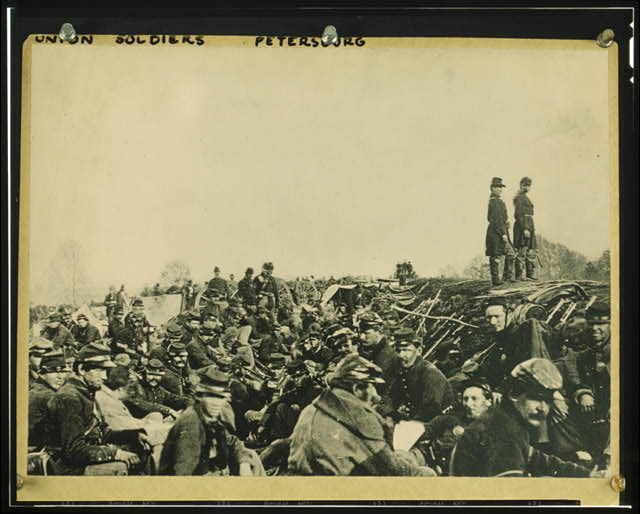
|
| Union Soldiers in Petersburg Trench |
(About) Photograph of Union soldiers in trench at Petersburg and prior to
the advance into the infamous Crater. Library of Congress.
Work on the tunnel had been continuously pushed from the start on June
25. By July 17 the diggers were nearly 511 feet from the entrance and directly beneath the battery in Elliott's Salient. The
Confederates had become suspicious by this time, for the faint sounds of digging could be heard issuing from the earth. Their
apprehension took the form of countermines behind their own lines. Several of these were dug in an effort to locate the Union
gallery. Two were very close, being sunk on either side of where the Pennsylvanians were at work. Although digging in the
countermines continued throughout the month of July, Confederate fears seemed to quiet down during the same period. There
were many reasons for this. One was the failure of their tunnels to strike any Union construction. Another major reason, undoubtedly,
was a belief held by many that it was impossible to ventilate a shaft of any length over 400 feet without constructing air
shafts along it.
The next step in the Union plan was to burrow out into lateral galleries
at the end of the long shaft. Accordingly, on July 18 work was begun on these branches which extended to the right and left,
paralleling the Confederate fortifications above. When completed, these added another 75 feet to the total length of the tunnel
which now reached 586 feet into the earth. It was about 20 feet from the floor of the tunnel to the enemy works above. The
average internal dimensions of the shaft were 5 feet high, with a base 4 1/2 feet in width tapering to 2 feet at the top.
Digging was finally completed on July 23. Four days later the task of
charging the mine with black powder was accomplished. Three hundred and twenty kegs of powder weighing, on the average, 25
pounds each were arranged in the two lateral galleries in eight magazines. The total charge was 4 tons, or 8,000 pounds. The
powder was sandbagged to direct the force of the explosion upward and two fuses were spliced together to form a 98-foot line.
Meanwhile, preparations for the attack which was to follow the explosion
of the mine had been carried out. Burnside was convinced of the necessity for a large-scale attack by the entire IX Corps.
His request was acceded to by Meade and Grant with but one important exception. It had been Burnside's hope that a fresh and
numerically strong (about 4,300) Negro division should lead the charge after the explosion. Meade opposed this on the grounds
that if the attack failed the Union commanders could be accused of wanting to get rid of the only Negro troops then with the
Army of the Potomac.
Burnside was not informed of this decision until the day before the battle, July 29, and he was forced to change his plans
at the last moment. Three white divisions were to make the initial charge along with the colored troops. Burnside had the
commanding generals of these three divisions draw straws to see which would lead. Gen. James F. Ledlie of the 1st Division
won the draw.
| From Battles and Leaders of the Civil War. |
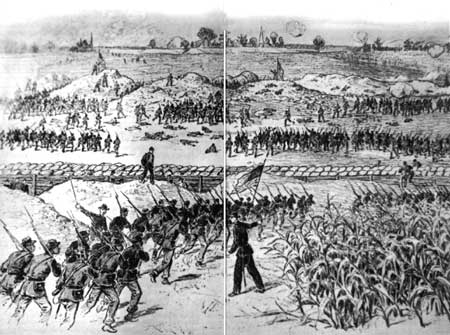
|
| Sketch by Waud showing Union charge to Crater. |
| From Battles and Leaders of the Civil War. |

|
| Explosion of Union Mine recorded by A.R. Waud. |
| Civil War Crater, July 30, 1863 |
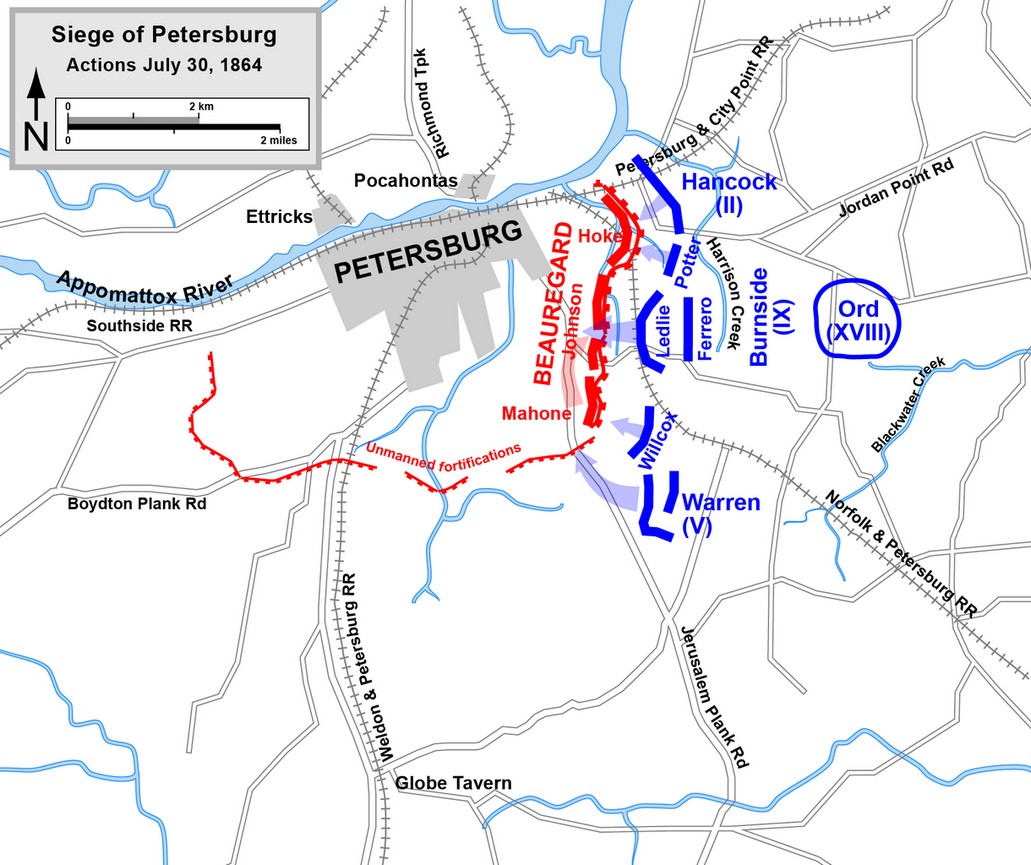
|
| Civil War Battle of the Crater Battlefield Map |
Despite these eleventh-hour changes, a plan of battle had been evolved. During
the night of July 29—30 the bulk of the IX Corps had assembled in the ravine behind the mine entrance. Troops from other
Union corps were sent to act as reinforcements. A total of 110 guns and 54 mortars was alerted to begin their shelling of
the Confederate line. A Union demonstration before Richmond had forced Lee to withdraw troops from Petersburg.
Only about 18,000 soldiers were left to guard the city.
At 3:15 a. m., July 30, Pleasants lit the fuse of the mine and mounted the
parapet to see the results of his regiment's work. The explosion was expected at 3:30 a. m. Minutes passed slowly by, and
the men huddled behind the lines grew more apprehensive. By 4:15 there could be no doubt but that something had gone wrong.
Two volunteers from the 48th Regiment (Lt. Jacob Douty and Sgt. Harry Reese) crawled into the tunnel and found that the fuse
had burned out at the splice. They relighted it and scrambled to safety. Finally, at about 4:45 a. m., the explosion took
place. The earth trembled as men, equipment, and debris were hurled high into the air. At least 278 Confederate troops were
killed or wounded in the tremendous blast, and 2 of the 4 guns in the battery were destroyed beyond repair. The measurements
of the size of the crater torn by the powder vary considerably, but it seems to have been at least 170 feet long, 60 to 80
feet wide, and 30 feet deep.
| Battle of the Mine & Crater Diagram |
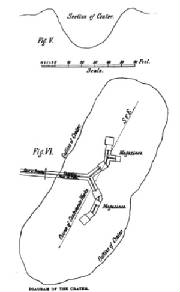
|
| (Civil War Virginia Crater Battlefield) |
| Battle of the Crater & Explosion Diagram |
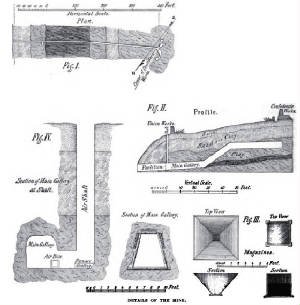
|
| (Civil War Crater Battle Plan and Attack Map) |
(About) (L) Battle of the Crater: Details of the Crater; (R) Battle
of the Crater: Diagram of the Mine. Courtesy Battles and Leaders of the Civil War, Volume 4, pp. 548-549.
The awesome spectacle of the mine explosion caused a delay in the Union
charge following the explosion. Removal of obstructions between the lines caused further delay. Soon, however, an advance
was made to the crater where many of the attacking force paused to seek shelter on its steep slopes or to look at the havoc
caused by the mine. The hard-pressed Confederates tallied quickly and soon were pouring shells and bullets into their opponents.
Union reinforcements poured into the breach; but, instead of going forward, they either joined their comrades in the crater
or branched out to the immediate right and left along the lines. By 8:30 that morning a large part of the IX Corps had been
poured into the captured enemy salient. Over 15,000 troops now filled and surrounded the crater.
By prompt action and determined effort the Confederates had stopped
the attack. The attention of three batteries was soon directed on the Blue-clad men in the crater. Repeated volleys of artillery
shot and shell raked the huddled groups of increasingly demoralized men. In addition, mortars were brought to within 50 yards
of the crater and started to drop shells on the soldiers with deadly effect.
Successful as these devices were in halting the Union advance, Lee was
aware that an infantry charge would be necessary to dislodge the enemy. By 6 a. m. an order had been sent to General Mahone
to move two brigades of his division from the lines south of Petersburg to the defense of the threatened position. Then
Lee joined Beauregard in observing the battle from the Gee house, 500 yards to the rear of the scene of strife.
| The Crater as it appeared in 1865. |

|
| The Crater at Petersburg as it appeared in 1865. |
In spite of the Confederate resistance,
most of the Northern Negro division and other regiments had, by 8 a. m., advanced a short distance beyond their companions
at the crater. Shortly after 8 o'clock Mahone's Confederate division began to arrive on the scene. The men fled into a ravine
about 200 yards west of the crater and between it and Petersburg. No sooner had they entered this protected position
than, perceiving the danger to their lines, they charged across the open field into the mass of enemy soldiers. Although outnumbered,
they forced the Northerners to flee back to the comparative shelter of the crater. Then they swept on to regain a portion
of the line north of the Union-held position. Again, at about 10:30 a. m., more of Mahone's troops charged, but were repulsed.
Meanwhile, the lot of the Northern soldiers was rapidly becoming unbearable. The spectacle within the crater was appalling.
Confederate artillery continued to beat upon them. The closely packed troops (dead, dying, and living mixed indiscriminately
together) lacked shade from the blazing sun, food, water and, above all, competent leadership. Meade had ordered their withdrawal
more than an hour before the second Confederate charge, but Burnside delayed the transmission of the order till after midday.
Many men had chosen to run the gantlet of fire back to their own lines, but others remained clinging to the protective sides
of the crater.
The last scene in the battle occurred shortly after 1 p. m. A final
charge by Mahone's men was successful in gaining the slopes of the crater. Some of the Union men overcome with exhaustion
and realizing the helplessness of their situation, surrendered; but others continued to fight. At one point where resistance
centered, the Confederates put their hats on ramrods and lifted them over the rim of the crater. The caps were promptly torn
to shreds by a volley. Before their foe could reload, Mahone's forces jumped into the
crater where a desperate struggle with bayonets, rifle butts, and fists ensued.
Soon it was all over. The Union Army had suffered a loss of some 4,000
in killed, wounded, captured or missing versus approximately 1,500 for the Confederates. Again, as on June 15—18,
a frontal assault had failed to take the Confederate citadel. Continue to Battle of the Crater: Overview, Timeline, Maps and Battlefield Positions.
(Sources listed at bottom of page.)
Recommended Reading: Battle of the Crater (Civil War Campaigns and Commanders).
Description: July 1864. Grant's siege of Petersburg is at
a standstill. A Federal regiment made up mostly of Pennsylvania
coal miners, under the command of Lt. Colonel Henry Pleasants, secures the reluctant approval of Generals Meade and, ultimately,
Grant to pursue an outrageous strategy: tunnel under the Confederate trenches, and blow up the Confederate troops. The 586-foot
tunnel is completed in a month. Continued below.
Four tons of powder explode in
a devastating surprise attack, killing hundreds of Confederate soldiers. Fearing bad publicity, white soldiers are substituted
for the division of black troops specially trained for the assault. Ill prepared, and without leadership, they charge through
Confederate lines and swarm around and incredibly, into the 170-foot crater, only to be trapped and slaughtered in a furious
counter charge. An absorbing story of extraordinary bravery and incompetent leadership based on first-person accounts.
Recommended Reading: No Quarter: The Battle
of the Crater, 1864.
Description: In this richly researched and dramatic work of military history, eminent historian Richard Slotkin recounts one
of the Civil War’s most pivotal events: the Battle of the Crater on July 30, 1864. At first glance, the Union’s plan seemed brilliant: A regiment of miners would burrow beneath a Confederate fort,
pack the tunnel with explosives, and blow a hole in the enemy lines. Then a specially trained division of African American
infantry would spearhead a powerful assault to exploit the breach created by the explosion. Continued below.
Thus, in one
decisive action, the Union would marshal its mastery of technology and resources, as well as demonstrate the superior morale
generated by the Army of the Potomac’s embrace of emancipation. At stake was the chance
to drive General Robert E. Lee’s Army of North Virginia away from the defense of the Confederate capital of Richmond–and
end the war. The result was something far different. The attack was hamstrung by incompetent leadership and political infighting
in the Union command. The massive explosion ripped open an immense crater, which became a death trap for troops that tried
to pass through it. Thousands of soldiers on both sides lost their lives in savage trench warfare that prefigured the brutal
combat of World War I. But the fighting here was intensified by racial hatred, with cries on both sides of “No quarter!”
In a final horror, the battle ended with the massacre of wounded or surrendering Black troops by the Rebels–and by some
of their White comrades in arms. The great attack ended in bloody failure, and the war would be prolonged for another year.
With gripping and unforgettable depictions of battle and detailed character portraits of soldiers and statesmen, No Quarter
compellingly re-creates in human scale an event epic in scope and mind-boggling in its cost of life. In using the Battle
of the Crater as a lens through which to focus the political and social ramifications of the Civil War–particularly
the racial tensions on both sides of the struggle–Richard Slotkin brings to readers a fresh perspective on perhaps the
most consequential period in American history. About the Author: Richard Slotkin is widely regarded as one of the preeminent
cultural critics of our times. A two-time finalist for the National Book Award, he is the author of Lost Battalions, a New
York Times Notable Book, and an award-winning trilogy on the myth of the frontier in America–Regeneration Through Violence,
The Fatal Environment, and Gunfighter Nation–as well as three historical novels: The Crater: A Novel, The Return of
Henry Starr, and Abe: A Novel of the Young Lincoln. He is the Olin Professor of English and American Studies at Wesleyan University
and lives in Middletown,
Connecticut.
Recommended
Reading:
The Final Battles of the Petersburg
Campaign: Breaking the Backbone of the Rebellion (Hardcover). Description: Six large-scale battles from
late March through April 2, 1865, were the culmination of more than nine months of bitter and continuous warfare between Robert
E. Lee and Ulysses S. Grant. The fighting climaxed in the decisive breakthrough by the Union Sixth Corps on April 2, just
six miles southwest of Petersburg. This Federal victory forced
Lee to evacuate Petersburg and Richmond
that night, and to surrender his army just one week later. An excellent study on the final union thrusts at Lee's defenses
at Petersburg that culminate not just with Sheridan and Warren's combined collapse of Pickett at Five Forks but the final
break through with the VI corps punching a hole in A. P. Hill's defenses that virtually cause a hemorrhage in the Petersburg
defenses only staved off by the heroic defenses at Fort Gregg and a line of artillery giving time for Lee to organize the
final retreat. Continued below.
Petersburg was a very complicated campaign that contains a series of modest
to large battles as Grant constantly moves forces west to cut off supplies and avenues of escape. As Greene describes well,
Lee constantly parried with creative engineering and counter attacks. Greene provides a detailed account of all these battles
that stretched over one time farms and wilderness outside of Petersburg.
Petersburg was a very complicated campaign and just driving the roads today around Petersburg to some of these still remote sites makes you appreciate
the effort of Greene's work. The final break through is at the center of Pamplin
Historical Park for the Civil
War Soldier where Greene is the Chief historian and CFO. Read the book then visit Pamplin Park, and see the extraordinary
well preserved trenches where the final break through occurred and walk the trail that leads to the Union jump off point and
then follow it right into the Confederate trenches where it leads right to the unique vulnerable spot of the line where the
union attack punched through. It is well worth seeing park with its living history, historic headquarters, outdoor exhibits
and a great modern museum. An excellent book for the serious Civil War student. Included: 25 original maps 36 photos and illustrations
6 x 9; Introduction by award-winning Petersburg historian
Richard J. Sommers; Based on manuscript sources and extensive research. About the Author: Will Greene, executive director
of Pamplin Historical Park, which preserves the Breakthrough Battlefield, places these long-neglected battles in strategic
context while providing the first tactically-detailed account of the combat on April 2, 1865. A. Wilson Greene is also the
author of Whatever You Resolve to Be, a collection of essays on Stonewall Jackson.
Recommended
Reading:
The Horrid Pit: The Battle of the Crater, the Civil War's Cruelest
Mission (Hardcover). Publishers Weekly:
One of the American Civil War's most horrific events took place on July 30, 1864: the slaughter of thousands of Union troops,
including many African-Americans, in a giant pit outside Petersburg, Va. “The Crater” was created as a result of a poorly planned and executed Union
mission to tunnel under, and then explode, the Confederate lines, thereby opening the gates to a full frontal assault on Petersburg
that, if successful, could have helped decide the war. Instead, after several hundred Confederates perished in the initial
mine explosion, the Union troops entered the crater—later known as The Pit—and were gunned down. Continued
below...
(The scene is re-created in the novel and film Cold Mountain.)
Civil War specialist Axelrod (The War Between the Spies, et al.) offers a concise, readable and creditable recounting of the
Battle of the Crater, which General U.S. Grant famously termed a stupendous failure. When the dust settled, the Union forces,
under the inept leadership of generals Ambrose E. Burnside and George Gordon Meade, suffered more than 4,000 killed, wounded
or captured. The well-led Confederates had about 1,500 casualties. The massive slaughter does not make for easy reading, but
is a reminder of the horror of war at its basest level.
Recommended Reading: Battle of the Crater: A Complete History
(Hardcover). Description: One sentence describes this massive study: "It is exhaustive, thorough, detailed, and complete...it
is the most comprehensive study of the crater, the mine." Continued below.
The
Battle
of the Crater is one of the lesser known yet most interesting battles of the Civil War. This book, detailing the onset of
brutal trench warfare at Petersburg, Virginia,
digs deeply into the military and political background of the battle. Beginning by tracing the rival armies through the bitter
conflicts of the Overland Campaign and culminating with the siege of Petersburg
and the battle intended to lift that siege, this book offers a candid look at the perception of the campaign by both sides.
Recommended Reading:
The Crater: Petersburg. Description:
A spectacular early morning underground explosion followed by bloody hand-to-hand combat and unprecedented command malfeasance
makes the story of the Crater one of the most riveting in Civil War history. Da Capo's new "Battleground America" series offers a unique approach to the battles and battlefields of America. Each book in the series highlights a small American
battlefield-sometimes a small portion of a much larger battlefield-and tells the story of the brave soldiers who fought there.
Using soldiers' memoirs, letters and diaries, as well as contemporary illustrations, the human ordeal of battle comes to life
on the page. Continued below…
All of the units, important individuals,
and actions of each engagement on the battlefield are described in a clear and concise narrative. Detailed maps complement
the text and illustrate small unit action at each stage of the battle. Then-and-now photographs tie the dramatic events of
the past to the modern battlefield site and highlight the importance of terrain in battle. The present-day historical site
of the battle is described in detail with suggestions for touring. About the Author: John Cannan has established a reputation
among civil War writers in remarkably short time. His distinctions include three books selected by the Military Book Club.
He is the author of The Atlanta Campaign, The Wilderness Campaign, and The Spotsylvania Campaign. He is an historic preservation
attorney living in Baltimore.
Recommended Reading: The 48th Pennsylvania in the Battle of the Crater:
A Regiment of Coal Miners Who Tunneled Under the Enemy (Hardcover). Description: In June 1864, Grant attempted to seize
the Confederate rail hub of Petersburg, Virginia.
General P.G.T. Beauregard responded by rushing troops to Petersburg
to protect the vital supply lines. A stalemate developed as both armies entrenched around the city. Union commander General
Ambrose Burnside advanced the unusual idea of allowing the 48th Pennsylvania—a regiment
from the mining town of Pottsville—to excavate a mine,
effectively tunneling under Confederate entrenchments. Continued below.
One of the most inventive and creative conflicts of the war, the Battle of the Crater ultimately became one of the most controversial,
as an almost certain Union victory turned into an astonishing Confederate triumph.
Recommended Reading:
Trench Warfare under Grant and Lee: Field Fortifications in the Overland Campaign (Civil War America) (Hardcover) (The University of North Carolina Press) (September
5, 2007). Description: In the study of field fortifications
in the Civil War that began with Field Armies and Fortifications in the Civil War, Hess turns to the 1864 Overland campaign
to cover battles from the Wilderness to Cold Harbor. Continued below.
With special emphasis on the role
of the 48th Pennsylvania,
this history provides an in-depth examination of the Battle
of the Crater, which took place during July 1864. Here, bickering between Federal commanders and a general breakdown of communications
allowed shattered Confederate troops the opportunity to regroup after a particularly devastating blow to their defenses. The
work examines the ways in which the personality conflict between generals George Meade and Ambrose Burnside ultimately cost
the Union an opportunity to capture Petersburg and bring an
early end to the war. On the other hand, it details the ways in which the cooperation of Confederate commanders helped to
turn this certain defeat into an unexpected Southern achievement. Appendices include a list of forces that took part in the
Battle of the Crater, a table of casualties from the battle
and a list of soldiers decorated for gallantry during the conflict.Drawing on meticulous research in primary sources
and careful examination of trench remnants at the Wilderness, Spotsylvania, North Anna, Cold Harbor, and Bermuda Hundred,
Hess describes Union and Confederate earthworks and how Grant and Lee used them in this new
era of field entrenchments.
Recommended Reading: Field Armies and Fortifications in the Civil War: The Eastern Campaigns, 1861-1864
(Civil War America) (Hardcover). Description: The eastern campaigns of the Civil War involved the widespread
use of field fortifications, from Big Bethel and the Peninsula to Chancellorsville, Gettysburg,
Charleston, and Mine Run. While many of these fortifications
were meant to last only as long as the battle, Earl J. Hess argues that their history is deeply significant. The Civil War
saw more use of fieldworks than did any previous conflict in Western history. Hess studies the use of fortifications by tracing
the campaigns of the Army of the Potomac and the Army of Northern Virginia from April 1861
to April 1864. Continued below...
He considers
the role of field fortifications in the defense of cities, river crossings, and railroads and in numerous battles. Blending
technical aspects of construction with operational history, Hess demonstrates the crucial role these earthworks played in
the success or failure of field armies. He also argues that the development of trench warfare in 1864 resulted from the shock
of battle and the continued presence of the enemy within striking distance, not simply from the use of the rifle-musket, as
historians have previously asserted.Based on fieldwork
at 300 battle sites and extensive research in official reports, letters, diaries, and archaeological studies, this book should
become an indispensable reference for Civil War historians.

Try the Search Engine for Related Studies: Battle
of the Crater, Petersburg Map, The Mine, Richmond - Petersburg Siege Civil War History, Battle of Petersburg, Union Confederate
Trench Warfare History, Battlefield Maps, Photo, Photos, Details.
Sources: Petersburg National Battlefield
Park; Civil War Preservation Trust; Battles and Leaders of the Civil
War; National Archives; Library of Congress; National Park Service.
|

